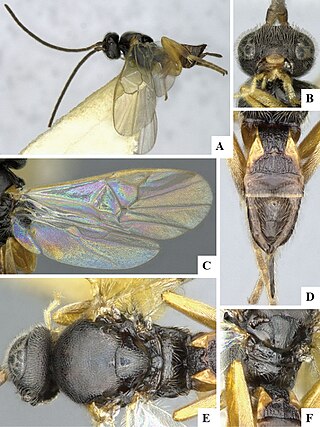
The Braconidae are a family of parasitoid wasps. After the closely related Ichneumonidae, braconids make up the second-largest family in the order Hymenoptera, with about 17,000 recognized species and many thousands more undescribed. One analysis estimated a total between 30,000 and 50,000, and another provided a narrower estimate between 42,000 and 43,000 species.

Microgastrinae is a subfamily of braconid wasps, encompassing almost 3,000 described species, with an estimated 30,000–50,000 total species. This makes it one of the richest subfamilies with the most species of parasitoid wasps.

The Doryctinae or doryctine wasps are a large subfamily of parasitoid wasps within the family Braconidae.

The Euphorinae are a large subfamily of Braconidae parasitoid wasps. Some species have been used for biological pest control. They are sister group to the Meteorinae.

Apanteles is a very large genus of braconid wasps, containing more than 600 described species found worldwide. There are no native species in New Zealand, and none have been recorded in the high arctic.

Dolichogenidea is a genus of parasitoid wasps in the family Braconidae. There are more than 360 described species in Dolichogenidea, found throughout the world.
Chrysopophthorus hungaricus is a species of hymenopteran in the family Braconidae, found in Europe.

The Alysiinae are a subfamily of braconid parasitoid wasps with over 1000 described species. Several species have been used in biocontrol programs. They are closely related to the Opiinae.

Microplitis is a genus of braconid wasps in the family Braconidae. There are more than 190 described species in Microplitis, found throughout the world.
Choeras is a genus of braconid wasps in the family Braconidae. There are at least 80 described species in Choeras, found worldwide.
Sathon is a genus of braconid wasps in the family Braconidae. There are more than 20 described species in Sathon, found throughout the world.
Clarkinella is a genus of braconid wasps in the family Braconidae. There are at least two described species in Clarkinella.
Deuterixys is a genus of braconid wasps in the family Braconidae. There are about 18 described species in Deuterixys, found throughout most of the world.

Exix is a genus of braconid wasps in the family Braconidae. There are about seven described species in Exix, found in North, Central, and South America.
Fornicia is a genus of braconid wasps in the family Braconidae. There are more than 30 described species in Fornicia, found mainly in Asia, Africa, and the Neotropics.
Iconella is a genus of braconid wasps in the family Braconidae. There are about 38 described species in Iconella, found throughout most of the world.
Illidops is a genus of braconid wasps in the family Braconidae. There are more than 30 described species in Illidops, found throughout most of the world.
Paroplitis is a genus of braconid wasps in the family Braconidae. There are about five described species in Paroplitis.

Pholetesor is a genus of braconid wasps in the family Braconidae. There are more than 50 described species in Pholetesor, found mainly in the Holarctic.
Venanus is a genus of braconid wasps in the family Braconidae. There are about 11 described species in Venanus, found in the New World.










